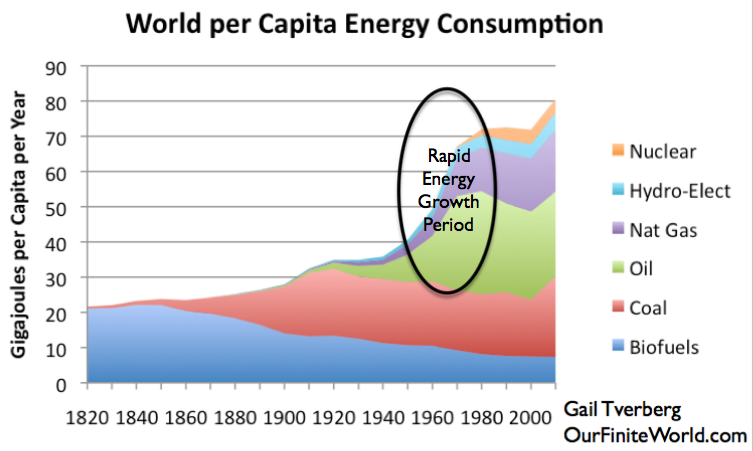2 Energy Overview
2.1 Energy Civilization
From early humans rubbing sticks together to make fire, to the fossil fuels that drove the industrial revolution, energy has played a central role in our development as a species. But the way we power our societies has also created humanity’s biggest challenge. It’s one that will take all our ingenuity to solve.
Energy is the key to humanity’s world domination.
We live in a fossil fuel society
But while they have lifted ever more of us out of agrarian hardship, and created our global economy and high living standards, the catastrophic climate change they are creating now threatens to derail that society.
Just as two centuries ago we reached the limits of what agriculture could do, now global warming is imposing a limit on what coal, oil and gas can safely do.
It has created the greatest challenge human society has ever faced - moving back to relying on the daily influx of energy from the Sun to meet the huge energy needs of eight billion people and counting.
Rowlatt (BBC) The Real Reason Humans are the Dominant Species
2.2 World Energy Outlook
The World Energy Outlook, the IEA’s flagship publication, provides a comprehensive view of how the global energy system could develop in the coming decades. This year’s exceptional circumstances require an exceptional approach. The usual long-term modelling horizons are kept but the focus for the World Energy Outlook 2020 is firmly on the next 10 years, exploring in detail the impacts of the Covid-19 pandemic on the energy sector, and the near-term actions that could accelerate clean energy transitions.
The analysis targets the key uncertainties facing the energy sector in relation to the duration of the pandemic and its implications, while mapping out the choices that would pave the way towards a sustainable recovery. The strategic insights from the WEO-2020 are based on detailed modelling of different potential pathways out of the crisis, covering all regions, fuels and technologies and using the latest data on energy markets, policies and costs.
(IEA pdf at 120 Euro!! - Why the ….need IEA to sell theirpublications?)
Ever since the agency was founded in 1974 to measure the world’s energy systems and anticipate changes, the yearly World Energy Outlook has been a must-read document for policymakers the world over.
Over the last two decades, however, the IEA has consistently failed to see the massive growth in renewable energy coming. Not only has the organisation underestimated the take-up of solar and wind, but it has massively overstated the demand for coal and oil.
Incredibly cheap Chinese Solar
The Chinese approach to renewables is all about energy security,” Mathews says. “At the scale from which they’re building new industries, they would need colossal imports of conventional fossil fuels, which would cripple them economically.
“They can get around that problem, which is a geopolitical obstacle, by manufacturing their own energy equipment.”
One such innovation is the stackable solar cell. Though still a niche technology very much in the early stages, the basic idea is to lay a material over a solar cell in order to boost its power output.
“We think a 40% module, rather than the 22% you can do nowadays with PERC, is what the industry will be doing once we perfect this stacking approach,” Green says. “We’re just trying to find a new cell that will have all the qualities of silicon that we can stack on top of silicon.
“The International Energy Agency now says solar is providing the cheapest energy the world has ever seen. But we’re headed towards a future of insanely cheap energy.
“It’s a fundamentally different world we’re moving into.”
2.3 Energy Power Game
Tooze
Realizing decarbonization is a one-way bet for Europe and Asia changes the oil and gas industry’s competitive game. So long as they could plan for the long term, OPEC and Russia could afford to contemplate a modus vivendi with shale. Once Eurasian decarbonization begins to accelerate in earnest, it will no longer makes sense for OPEC and Russia to continue the game. Faced with the fossil fuel endgame, a final price war is their best strategy. The result will be a massive shock to oil and gas prices. And this time, as demand for fossil fuels progressively shrinks, low prices will be permanent. The losers in that ferocious competition will be high-cost producers around the world. Once decarbonization takes hold, what will dominate the remaining oil and gas markets is leading OPEC members’ ultra-low cost base.
Whereas competing with Saudi Arabia and Qatar in dwindling global markets for oil and gas is a fool’s errand, electricity markets are protected by the cost of long-distance transmission.
2.4 World Energy Consumption per Capita

Figure: World per capita energy consumption, with the 1950-1980 period of rapid growth highlighted. World Energy Consumption by source, based on Vaclav Smil’s estimates from Energy Transitions: History, Requirements and Prospects (Appendix) together with data from BP’s Statistical Review of World Energy for 1965 and subsequent years. Population estimates used to produce per capita amounts are based on estimates by Angus Maddison for dates prior to 1950. They are based on UN estimates for more recent years. Chart prepared by Gail Tverberg in 2018.*
Tverberg (2023) Today’s energy bottleneck may bring down major governments